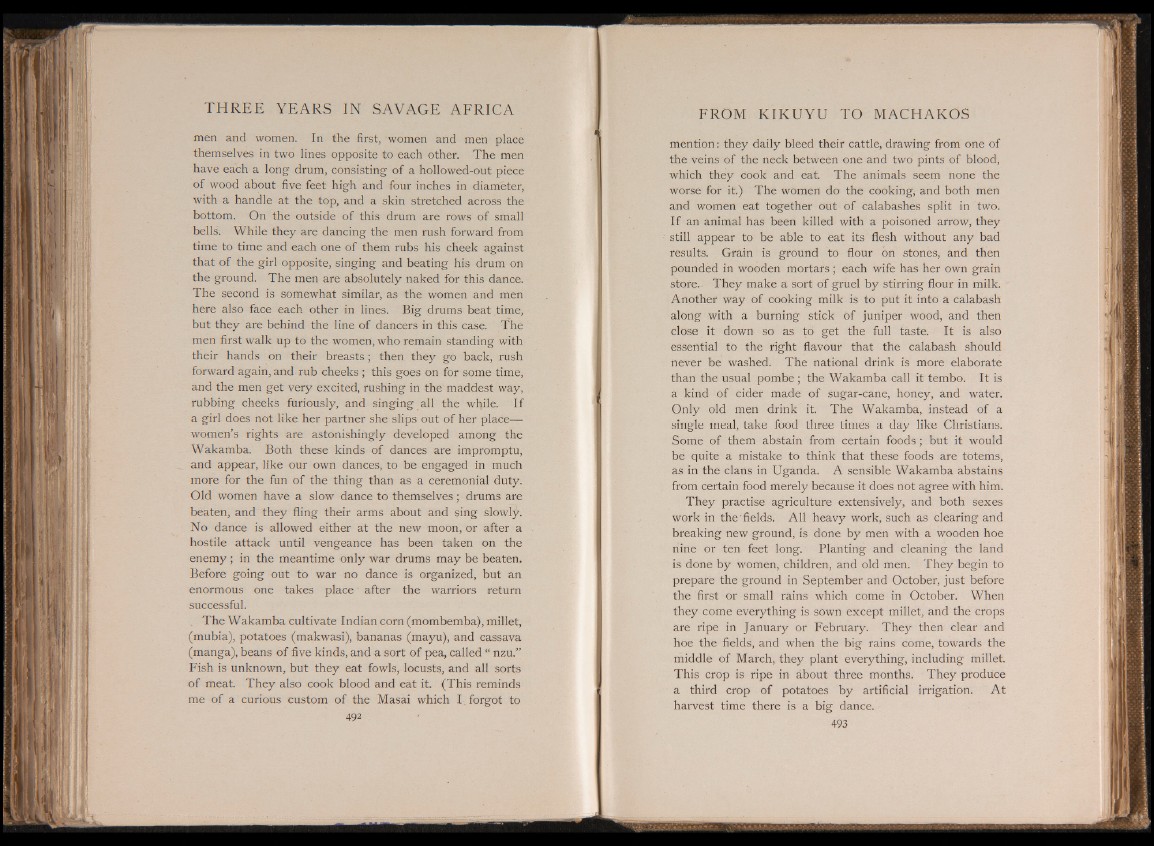
men and women. In the first, women and men place
themselves in two lines opposite to each other. The men
have each a long drum, consisting of a hollowed-out piece
of wood about five feet high and four inches in diameter,
with a handle at the top, and a skin stretched across the
bottom. On the outside of this drum are rows of small
bells. While they are dancing the men rush forward from
time to time and each one of them rubs his cheek against
that of the girl opposite, singing and beating his drum on
the ground. The men are absolutely naked for this dance.
The second is somewhat similar, as the women and men
here also face each other in lines. Big drums beat time,
but they are behind the line of dancers in this case. The
men first walk up to the women, who remain standing with
their hands on their breasts; then they go back, rush
forward again, and rub cheeks ; this goes on for some time,
and the men get very excited, rushing in the maddest way,
rubbing cheeks furiously, and singing all the while. If
a girl does not like her partner she slips out of her placesS
women’s rights are astonishingly developed among the
Wakamba. Both these kinds of dances are impromptu,
and appear, like our own dances, to be engaged in much
more for the fun of the thing than as a ceremonial duty.
Old women have a slow dance to themselves; drums are
beaten, and they fling their arms about and sing slowly.
No dance is allowed either at the new moon, or after a
hostile attack until vengeance has been taken on the
enemy; in the meantime only war drums may be beaten.
Before going out to war no dance is organized, but an
enormous one takes place after the warriors return
successful.
The Wakamba cultivate Indian corn (mombemba), millet,
(mubia), potatoes (makwasi), bananas (mayu), and cassava
(manga), beans of five kinds, and a sort of pea, called “ nzu.”
Fish is unknown, but they eat fowls, locusts, and all sorts
of meat. They also cook blood and eat it. (This reminds
me of a curious custom of the Masai which I . forgot to
mention: they daily bleed their cattle, drawing from one of
the veins of the neck between one and two pints of blood,
which they cook and eat. The animals seem none the
worse for it.) The women do the cooking, and both men
and women eat together out of calabashes split in two.
If an animal has been killed with a poisoned arrow, they
still appear to be able to eat its flesh without any bad
results. Grain is ground to flour on stones, and then
pounded in wooden mortars; each wife has her own grain
store. They make a sort of gruel by stirring flour in milk.
Another way of cooking milk is to put it into a calabash
along with a burning stick of juniper wood, and then
close it down so as to get the full taste. It is also
essential to the right flavour that the calabash should
never be washed. The national drink is more elaborate
than the usual pombe ; the Wakamba call it tembo. It is
a kind of cider made of sugar-cane, honey, and water.
Only old men drink it. The Wakamba, instead of a
single meal, take food three times a day like Christians.
Some of them abstain from certain foods; but it would
be quite a mistake to think that these foods are totems,
as in the clans in Uganda. A sensible Wakamba abstains
from certain food merely because it does not agree with him.
They practise agriculture extensively, and both sexes
work in the'fields. All heavy work, such as clearing and
breaking new ground, is done by men with a wooden hoe
nine or ten feet long. Planting and cleaning the land
is done by women, children, and old men. They begin to
prepare the ground in September and October, just before
the first or small rains which come in October. When
they come everything is sown except millet, and the crops
are ripe in January or February. They then clear and
hoe the fields, and when the big rains come, towards the
middle of March, they plant everything, including millet.
This crop is ripe in about three months. They produce
a third crop of potatoes by artificial irrigation. At
harvest time there is a big dance.